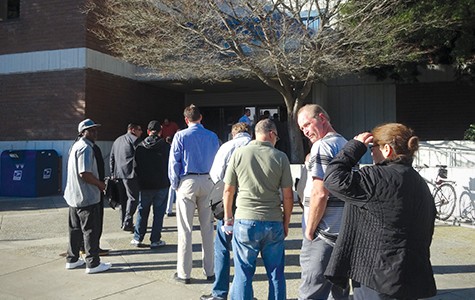At a time when skyrocketing rents are displacing low-income renters in Oakland, Alameda, and Berkeley, the Alameda County Superior Court is proposing to move all eviction cases to the Hayward Hall of Justice, even though the courthouse is not easily accessible by public transportation. Tenants advocates say the plan will create additional hardships for renters who live in the northern part of the county, don’t drive, can’t afford to hire their own attorney, and are facing eviction proceedings, also known as “unlawful detainer” cases.
“A lot of people will suffer as a result of moving unlawful detainer cases to Hayward,” said Chanee Franklin, an attorney who works for the Berkeley Rent Board.
“This is a bad idea — straight up,” said Leah Simon-Weisberg, legal director of Tenants Together, a statewide tenant advocacy group.
The plan to move all eviction cases in Alameda County to one courthouse in Hayward is part of a dramatic consolidation proposal by Alameda County Superior Court Judge Morris Jacobson. The plan would also centralize court assistance in Hayward for people who can’t afford to hire their own attorney. Many public officials and legal advocates say the planned court reorganization will harm low-income people and reduce equal access to justice.
Currently, two self-help centers, one in Oakland, and the other in Hayward, assist members of the public who represent themselves in non-criminal cases. The centers’ staff members hold workshops and explain the court’s often byzantine requirements for filing paperwork and pleading cases. Judge Jacobson’s plan is to close a self-help center in Oakland’s Rene C. Davidson Courthouse and to consolidate staff and budget resources to the Hayward Hall of Justice at an expanded self-help center.
In an interview, Jacobson blamed state budget cuts for the need to consolidate services. He said state support for the Alameda County courts has dropped from $107 million in 2008–2009 to just $82 million this year, and that the reorganization is the best way to enact cuts that don’t deny equal access to justice. “Our allocation in the state general fund is going to drop next year and the year after that,” said Jacobson. “It’s like we’re downsizing from a size ten shoe to a size seven, or size six. We’re not going back to a size ten.”
The court is also planning to discontinue hearing certain types of cases in Oakland’s Wiley Manuel and Rene C. Davidson courthouses, and the George E. McDonald Hall of Justice in the City of Alameda. The types of cases moved out of these locations would include family law, probate, small claims, and restraining orders. Instead, these types of cases will also only be heard in Hayward.
Simon-Weisberg said Los Angeles courts carried out a similar reorganization in 2013, resulting in the closure of courthouses and consolidation into “hubs.” Los Angeles Court consolidation has been opposed by numerous attorneys, legal aid groups, and unions. “It had detrimental effects in Los Angeles, and it will here, too,” said Simon-Weisberg.
On December 14, Jay Kelekian, executive director of the Berkeley Rent Board, sent a letter to Judge Jacobson, urging a postponement of the reorganization plan “until a more open and transparent exploration of options is conducted with all relevant stakeholders.” Kelekian and Franklin said in an interview last week that Judge Jacobson’s plan was presented only to attorneys through the Alameda County Bar Association and that the broader public has not been given the opportunity to weigh in on its merits. They said the public should be able to see the full plan and comment on it because the types of cases being moved are those in which litigants often don’t hire an attorney.
Oakland City Attorney Barbara Parker has also objected to Jacobson’s consolidation plan because of the impact it might have on tenants and low-income people. In a December 30 letter to Judge Jacobson, Parker wrote that “the relocation of these critical court functions to Hayward will severely and disproportionately impact the more vulnerable populations of our county.” Parker asked that unlawful detainer (eviction) cases continue to be heard in Oakland, and that Oakland’s self-help center remain open. “Having only one self-help center in a location that is not easily accessible by public transportation will limit its use by the very people who need these services,” wrote Parker.
Jacobson said he believes consolidation will actually improve access to the courts. Because of an existing shortage of staffers and funds, the self-help centers in Oakland and Hayward are currently only open from 8:30 a.m. to 12:00 p.m. But after the consolidation, the single Hayward self-help center will be open until 5 p.m., said Jacobson. The Hayward center will also be expanded by converting an existing courtroom into semi-private cubicles where the public can meet one-on-one with staffers to learn about court procedures, thereby providing more privacy. Currently, the Hayward self-help center, like the Oakland center, consists of a small office in the court’s hallway with windows where members of the public are assisted. Long lines and lengthy waits are common, and privacy is virtually nil. Jacobson admitted that the Hayward Hall of Justice is far from public transportation, but he said the court is looking into setting up a free or low-cost shuttle from the Hayward BART station.
On Tuesday morning of this week, I traveled by public transportation from my apartment in East Oakland to the Hayward Hall of Justice. The bus ride to the Fruitvale BART station took twenty minutes, and then my BART train ride to Hayward took another twenty minutes. In Hayward, I was confused by the bus system, so I rode my bike instead to the courthouse. In total, the trip took one hour. By contrast, I can reach the Oakland courthouses in just twenty minutes on a single bus ride.
Court officials say their plan makes sense in geographic terms. In a letter responding to Parker’s concerns, Chad Finke, the court executive officer, wrote that “Alameda County is roughly shaped like the letter ‘L,’ with Hayward at the ‘corner’ where the two ‘prongs’ of the county meet.” Finke wrote that this makes Hayward the most logical spot for consolidating court resources and case hearings for unlawful detainers and other matters.
But Oakland and Berkeley officials and legal advocates said any cost savings the courts will gain from moving unlawful detainer cases to Hayward will be more than offset by the harm done to renters, especially those from low-income households. They said the logic used by the court to justify locating unlawful detainer hearings in Hayward ignores the county’s demographics. Most low-income renters live in the cities clustered in the northwest corner of the county, and this same region is seeing dramatic rent increases.
“My concern is that at a time when we’re in a housing crisis, and there’s lots of pressure on tenants — that this will make it a lot more difficult for people to keep their housing,” said Berkeley City Councilmember Jesse Arreguin. He said there has been an increasing number of tenants evicted from rent-controlled Berkeley apartments on technical grounds by landlords who want to dramatically raise rents. “This consolidation plan will make it hard for people to defend themselves against … evictions like these, so the timing is just terrible.”
Franklin said that unlawful detainers are unique among legal proceedings because they are expedited for speedy hearings, and if a tenant loses in court, then the tenant loses his or her housing. For this reason, Franklin said it makes sense to hold unlawful detainer hearings as close to the tenant and landlord as possible, and not to consolidate these types of cases in distant courthouses.
“Three days after a tenant loses an eviction lawsuit, the sheriff shows up and changes their locks, so the consequences are dire,” said Franklin.
Oakland has by far the largest population of renters among Alameda County cities. According to City of Oakland records, about 59 percent of Oakland’s residents are renters. And according to the most recent US Census estimates, there are approximately 93,000 rental housing units in Oakland, and 40 percent of all renters in Alameda County live in Oakland. Berkeley and Fremont are virtually tied for the second highest number of rental housing units. Adding Berkeley, Alameda, Emeryville, and Albany to Oakland, the northern end of Alameda County holds 60 percent of all rental housing units.
Furthermore, census figures show also that the average renter in Oakland is much more likely to have a lower income than renters in cities in southern Alameda County cities like Fremont, Livermore, and Pleasanton. For example, in 2014, the median household income for renters in Oakland was $52,000 whereas the average renter household in Pleasanton had an income of $74,000.
“If they have to do this, do everything, but keep the eviction cases in Oakland,” said Franklin.
Correction: the original version of this story erroneously stated that the median household income for renters in Oakland in 2014 was $52,000, whereas the average renter household in Pleasanton had an income of $74,000. The true median household income for Oakland renters in 2014 was $40,250, whereas renter households in Pleasanton had a median income of $77,645.

















